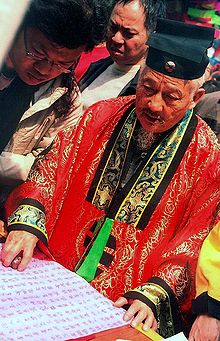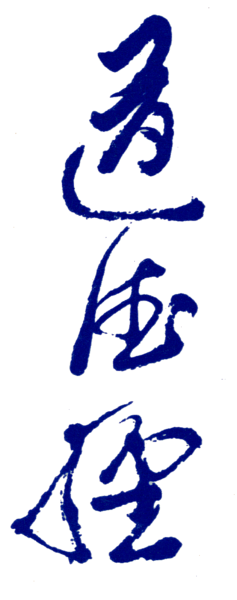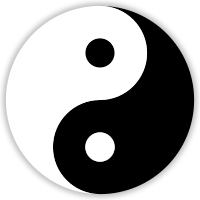|
Home: Religion: Taoism: Teachings.
Teachings and Scriptures of Taoism
 The Tao Te Ching, or Daodejing, is the most influential Taoist text.
|
|
![]()
Tao Te Ching
The Name that can be named is not the constant Name. It is a foundational scripture of central importance in Taoism purportedly written by Lao Tzu sometime in the 3rd or 4th centuries BC. It has been used as a ritual text throughout the history of religious Taoism. Taoist commentators have deeply considered the opening lines of the Tao Te Ching. They are widely discussed in both academic and mainstream literature. A common interpretation is similar to Korzybski's observation that "the map is not the territory". Tao literally means "path" or "way" and can figuratively mean "essential nature", "destiny", "principle", or "true path". |
 Taoist Priest in Macau |
Tao: the Path, or 'The Way'
The philosophical and religious "Tao" is infinite, without limitation. One view states that the paradoxical opening is intended to prepare the reader for teachings about the unteachable Tao. Tao is believed to be transcendent, indistinct and without form. Hence, it cannot be named or categorized. Even the word "Tao" can be considered a dangerous temptation to make Tao a limiting "name". The Tao Te Ching is not thematically ordered. However, the main themes of the text are repeatedly expressed using variant formulations, often with only a slight difference. The leading themes revolve around the nature of Tao and how to attain it. Tao is said to be unnameable and accomplishing great things through small means. There is significant debate regarding which English translation of the Tao Te Ching is preferred, and which particular translation methodology is best. Discussions and disputes about various translations of the Tao Te Ching can become acrimonious, involving deeply entrenched views.
The Tao Te Ching is not thematically ordered. However, the main themes of the text are repeatedly expressed using variant formulations, often with only a slight difference. The leading themes revolve around the nature of Tao and how to attain it. Tao is said to be unnameable and accomplishing great things through small means. There is significant debate regarding which English translation of the Tao Te Ching is preferred, and which particular translation methodology is best. Discussions and disputes about various translations of the Tao Te Ching can become acrimonious, involving deeply entrenched views.
Tao Te Ching or Dao De Jing
The Tao Te Ching or Dao De Jing, whose authorship has been attributed to Laozi, is a Chinese classic text. Its name comes from the opening words of its two sections: dào "way," and dé "virtue," plus 經 jīng "classic." According to tradition, it was written around the 6th century BC by the sage Laozi (or Lao Tzu, "Old Master"), a record-keeper at the Zhou Dynasty court, by whose name the text is known in China. The text's true authorship and date of composition or compilation are still debated.
The Tao Te Ching is fundamental to the Philosophical Taoism (Dàojiā 道家) and strongly influenced other schools, such as Legalism and Neo-Confucianism. This ancient book is also central in Chinese religion, not only for Religious Taoism but Chinese Buddhism, which when first introduced into China was largely interpreted through the use of Taoist words and concepts. Many Chinese artists, including poets, painters, calligraphers, and even gardeners have used the Tao Te Ching as a source of inspiration. Its influence has also spread widely outside East Asia, aided by hundreds of translations into Western languages.
The Wade–Giles romanization, Tao Te Ching, dates back to early English transliterations in the late 19th century, and many people continue using it, especially for words and phrases that have become well-established in English. The pinyin romanization Daodejing originated in the late 20th century, and this romanization is becoming increasingly popular, having been adopted as the official system by the Chinese government.
The Tao Te Ching has a long and complex textual history. On one hand, there are transmitted versions and commentaries that date back two millennia; on the other, there are ancient bamboo, silk, and paper manuscripts that archeologists discovered in the last century.
The Tao Te Ching states that the Tao is ineffable, i.e., the Tao is nameless, goes beyond distinctions, and transcends language. In Laozi's Qingjing Jing he clarified the term Tao was nominated as he was trying to describe a state of existence before it happened and before time or space. Way or path happened to be the side meaning of Tao, ineffability would be just poetic. This is the Chinese creation myth from the primordial Tao. In the first twenty-four words in Chapter one, the author articulated an abstract cosmogony, in what would be the world outside of the cave before it took shape by Plato in his allegory of the cave.
![]()
Taoism and Buddhism
The relation between Taoism and Buddhism and Chan Buddhism is complex and fertile. Similarly, the relationship between Taoism and Confucianism is richly interwoven, historically.In 1823 the French sinologist Jean-Pierre-Abel Rémusat suggested a relationship between Abrahamic faiths and Taoism; he held that Yahweh was signified by three words; yi ("calm; level; barbarian"), xi ("rare; indiscernible; hope"), and wei ("tiny, small; obscure"). James Legge dismissed this hypothetical yi-xi-wei and Yahweh connection as "a mere fancy or dream". According to Holmes Welch:
- It is not hard to understand the readiness of early scholars to assert that the doctrine of the Trinity was revealed in the Tao Te Ching and that its fourteenth chapter contains the syllables of "Yahveh." Even today, though these errors have been recognized for more than a century, the general notion that Lao Tzu was Christ's forerunner has lost none of its romantic appeal.

Ancient commentaries on the Tao Te Ching are important texts in their own right. The Heshang Gong commentary was most likely written in the second century AD, and as perhaps the oldest commentary, contains the edition of the Tao Te Ching that was transmitted to the present day. Other important commentaries include the Xiang'er, one of the most important texts from the Way of the Celestial Masters, and Wang Bi's commentary.
![]()
Tao and Zhuangzi
The Zhuangzi (莊子) is traditionally attributed to a Taoist sage of the same name, but this has recently been disputed in western academia. Zhuangzi also appears as a character in the book's narrative. The Zhuangzi contains prose, poetry, humour and disputation. The book often is seen as complex and paradoxical as the arguments and subjects of discussion are not those common to classical Western philosophy, such as the doctrine of Name Rectification (Zhengming) and correctly making "this/not-this" distinctions (shi/fei).[citation needed] Among the cast of characters in the Zhuangzi's stories is Laozi of the Tao Te Ching, as well as Confucius.![]()
Daozang
The Daozang (Treasury of Tao) is sometimes referred to as the Taoist canon. It was originally compiled during the Jin, Tang, and Song dynasties. The version surviving today was published during the Ming dynasty. The Ming Daozang includes almost 1500 texts. Following the example of the Buddhist Tripitaka, it is divided into three dong ("caves", "grottoes"). They are arranged from "highest" to "lowest":- 1. The Zhen ("real" or "truth") grotto. Includes the Shangqing texts.
. The Xuan ("mystery") grotto. Includes the Lingbao scriptures.
3. The Shen ("divine") grotto. Includes texts predating the Maoshan revelations.
The Shangqing school has a tradition of approaching Taoism through scriptural study. It is believed that by reciting certain texts often enough one will be rewarded with immortality.
![]()
Other Tao Texts
While the Tao Te Ching is most famous, there are many other important texts in traditional Taoism. Taishang Ganying Pian ("Treatise of the Exalted One on Response and Retribution") discusses sin and ethics, and has become a popular morality tract in the last few centuries. It asserts that those in harmony with Tao will live long and fruitful lives. The wicked, and their descendants, will suffer and have shortened lives. Both the Tai Ping Jing ("Scripture on Great Peace") and the Bao Pu Zi ("Book of the Master Who Keeps to Simplicity") contain early alchemical formulas that early Taoists believed could lead to immortality.Additionally, the Huainanzi is a compilation of the writing of eight scholars from Han dynasty that blends Daoist, Confucianist, and Legalist concepts, including theories such as Yin-Yang and the Five Phases. Patron Liu An (c. 180 - 122 BCE) was ruler of the state of Huainan and the grandson of the founder of the Han dynasty whose discourse at his court favored Taoist thought and who brought philosophers, poets and masters of esoteric practices to his court. This resulted in the Huainanzi.
![]()
Tao Scripture Links
- Daodejing Wang Bi edition with English translation
- Mawangdui text Chinese Text Project
- Lǎozǐ Dàodéjīng
- Tao Te Ching
- Daode jing (Isabelle Robinet), entry in The Encyclopedia of Taoism
- Tao Te Ching, James Legge
- The Tao Te Ching Frederic H. Balfour
- The Tao Teh King, Aleister Crowley
- Tao Te Ching Translations
Parts of the above article are licensed under the GNU Free Documentation License. It uses material from Wikipedia. Images courtesy FCIT
![]()
Copyright Important.ca ©. All rights reserved.
